University Accounting Information System Report: Fraud Analysis
VerifiedAdded on 2022/11/17
|6
|1123
|476
Report
AI Summary
This report examines fraud prevention and detection within an accounting information system. It analyzes two scenarios: one involving a company overpaying a promotions company due to inflated response numbers, and another where freight and travel expenses were significantly inflated. The report identifies five procedures to reduce fraud risk, including documentation, duty segregation, embracing technology, hiring experts, and knowing business partners. It then explores detective internal controls, such as internal audits, surprise inventory taking, surprise cash counts, and review of accounting work, which could have mitigated the fraud. The report further evaluates journal entries, budget versus expenditure analysis, and the significance of complicated account names and multiple bank accounts in detecting potential fraud. It emphasizes the importance of reviewing past audit reports to identify high-risk areas and prevent financial irregularities. The report provides references to support the findings.
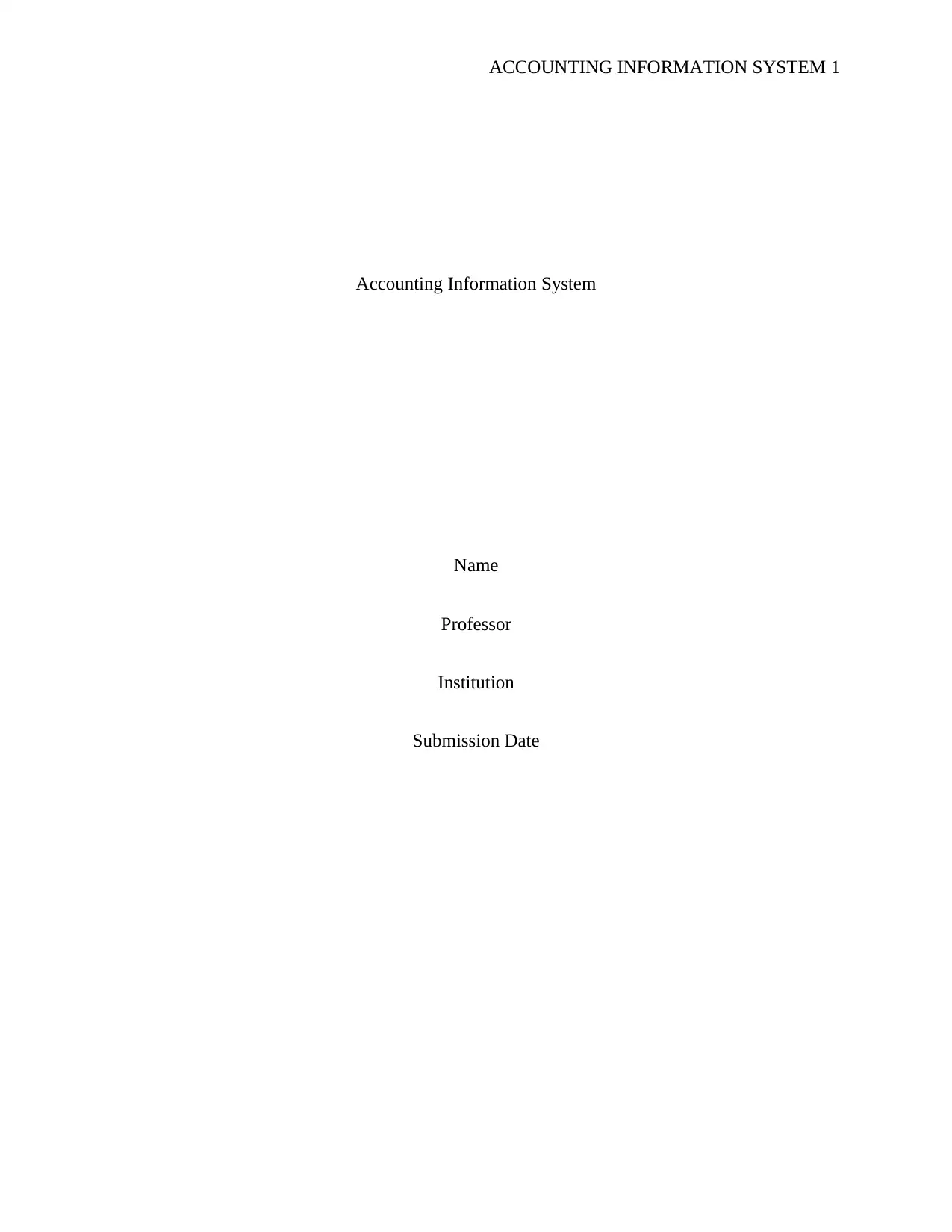
ACCOUNTING INFORMATION SYSTEM 1
Accounting Information System
Name
Professor
Institution
Submission Date
Accounting Information System
Name
Professor
Institution
Submission Date
Paraphrase This Document
Need a fresh take? Get an instant paraphrase of this document with our AI Paraphraser
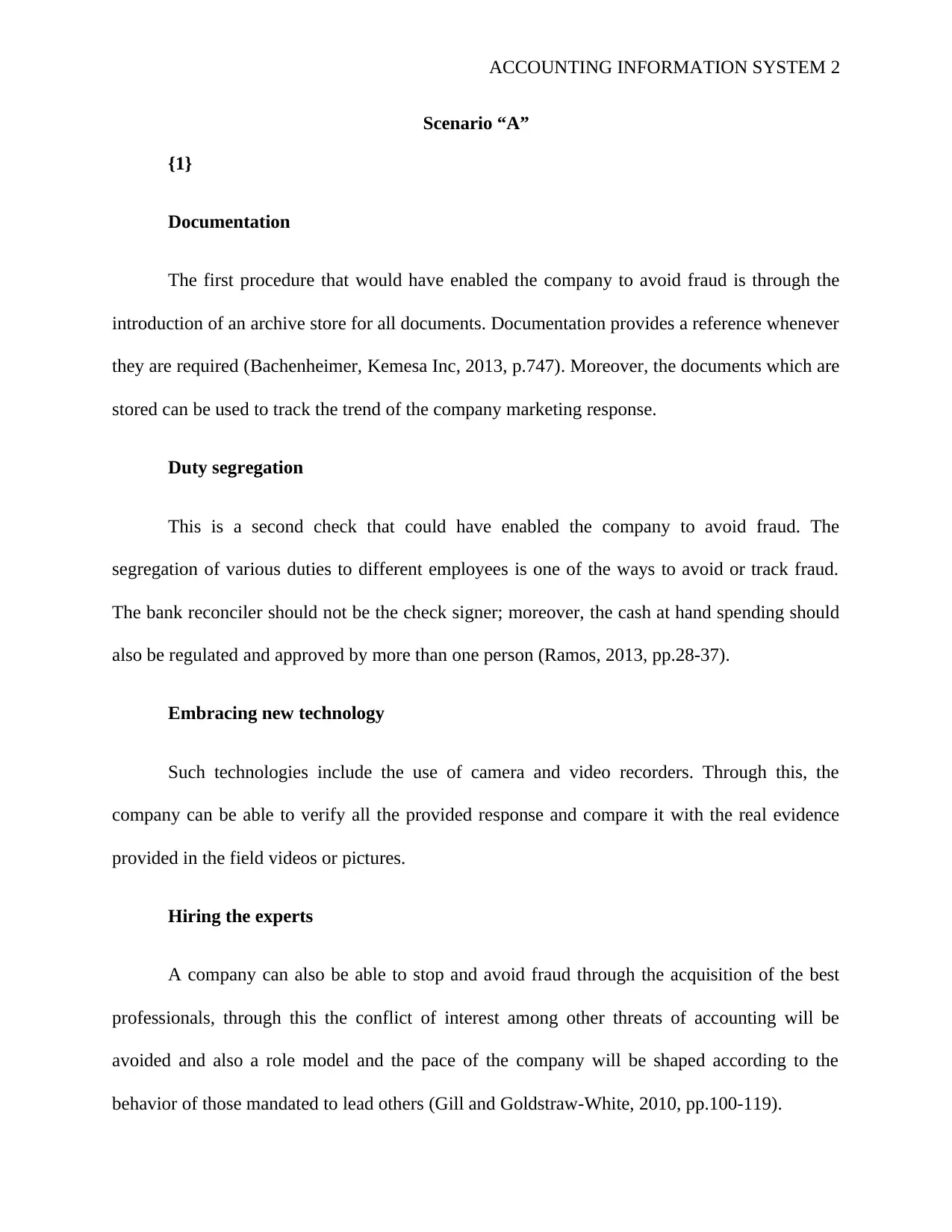
ACCOUNTING INFORMATION SYSTEM 2
Scenario “A”
{1}
Documentation
The first procedure that would have enabled the company to avoid fraud is through the
introduction of an archive store for all documents. Documentation provides a reference whenever
they are required (Bachenheimer, Kemesa Inc, 2013, p.747). Moreover, the documents which are
stored can be used to track the trend of the company marketing response.
Duty segregation
This is a second check that could have enabled the company to avoid fraud. The
segregation of various duties to different employees is one of the ways to avoid or track fraud.
The bank reconciler should not be the check signer; moreover, the cash at hand spending should
also be regulated and approved by more than one person (Ramos, 2013, pp.28-37).
Embracing new technology
Such technologies include the use of camera and video recorders. Through this, the
company can be able to verify all the provided response and compare it with the real evidence
provided in the field videos or pictures.
Hiring the experts
A company can also be able to stop and avoid fraud through the acquisition of the best
professionals, through this the conflict of interest among other threats of accounting will be
avoided and also a role model and the pace of the company will be shaped according to the
behavior of those mandated to lead others (Gill and Goldstraw-White, 2010, pp.100-119).
Scenario “A”
{1}
Documentation
The first procedure that would have enabled the company to avoid fraud is through the
introduction of an archive store for all documents. Documentation provides a reference whenever
they are required (Bachenheimer, Kemesa Inc, 2013, p.747). Moreover, the documents which are
stored can be used to track the trend of the company marketing response.
Duty segregation
This is a second check that could have enabled the company to avoid fraud. The
segregation of various duties to different employees is one of the ways to avoid or track fraud.
The bank reconciler should not be the check signer; moreover, the cash at hand spending should
also be regulated and approved by more than one person (Ramos, 2013, pp.28-37).
Embracing new technology
Such technologies include the use of camera and video recorders. Through this, the
company can be able to verify all the provided response and compare it with the real evidence
provided in the field videos or pictures.
Hiring the experts
A company can also be able to stop and avoid fraud through the acquisition of the best
professionals, through this the conflict of interest among other threats of accounting will be
avoided and also a role model and the pace of the company will be shaped according to the
behavior of those mandated to lead others (Gill and Goldstraw-White, 2010, pp.100-119).
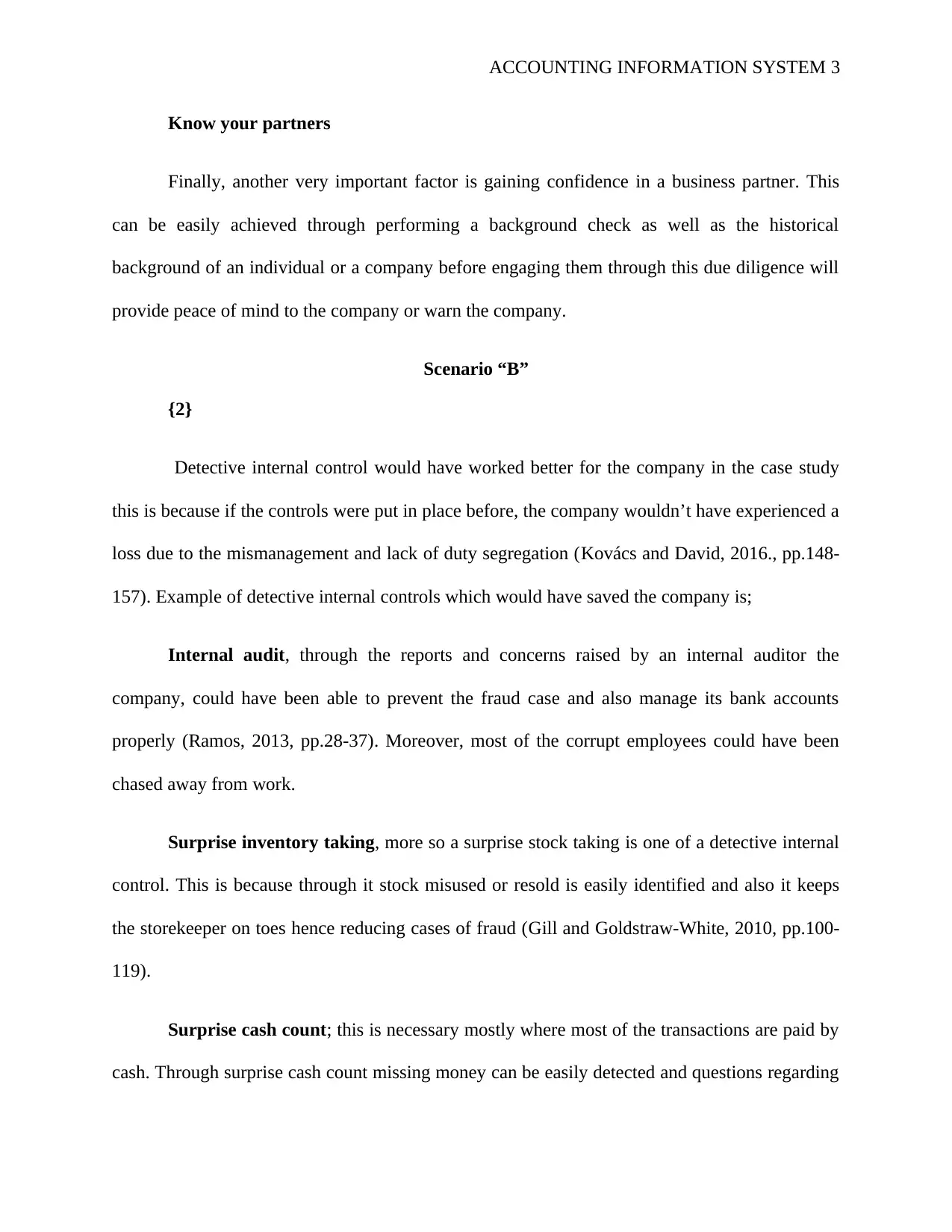
ACCOUNTING INFORMATION SYSTEM 3
Know your partners
Finally, another very important factor is gaining confidence in a business partner. This
can be easily achieved through performing a background check as well as the historical
background of an individual or a company before engaging them through this due diligence will
provide peace of mind to the company or warn the company.
Scenario “B”
{2}
Detective internal control would have worked better for the company in the case study
this is because if the controls were put in place before, the company wouldn’t have experienced a
loss due to the mismanagement and lack of duty segregation (Kovács and David, 2016., pp.148-
157). Example of detective internal controls which would have saved the company is;
Internal audit, through the reports and concerns raised by an internal auditor the
company, could have been able to prevent the fraud case and also manage its bank accounts
properly (Ramos, 2013, pp.28-37). Moreover, most of the corrupt employees could have been
chased away from work.
Surprise inventory taking, more so a surprise stock taking is one of a detective internal
control. This is because through it stock misused or resold is easily identified and also it keeps
the storekeeper on toes hence reducing cases of fraud (Gill and Goldstraw-White, 2010, pp.100-
119).
Surprise cash count; this is necessary mostly where most of the transactions are paid by
cash. Through surprise cash count missing money can be easily detected and questions regarding
Know your partners
Finally, another very important factor is gaining confidence in a business partner. This
can be easily achieved through performing a background check as well as the historical
background of an individual or a company before engaging them through this due diligence will
provide peace of mind to the company or warn the company.
Scenario “B”
{2}
Detective internal control would have worked better for the company in the case study
this is because if the controls were put in place before, the company wouldn’t have experienced a
loss due to the mismanagement and lack of duty segregation (Kovács and David, 2016., pp.148-
157). Example of detective internal controls which would have saved the company is;
Internal audit, through the reports and concerns raised by an internal auditor the
company, could have been able to prevent the fraud case and also manage its bank accounts
properly (Ramos, 2013, pp.28-37). Moreover, most of the corrupt employees could have been
chased away from work.
Surprise inventory taking, more so a surprise stock taking is one of a detective internal
control. This is because through it stock misused or resold is easily identified and also it keeps
the storekeeper on toes hence reducing cases of fraud (Gill and Goldstraw-White, 2010, pp.100-
119).
Surprise cash count; this is necessary mostly where most of the transactions are paid by
cash. Through surprise cash count missing money can be easily detected and questions regarding
⊘ This is a preview!⊘
Do you want full access?
Subscribe today to unlock all pages.

Trusted by 1+ million students worldwide
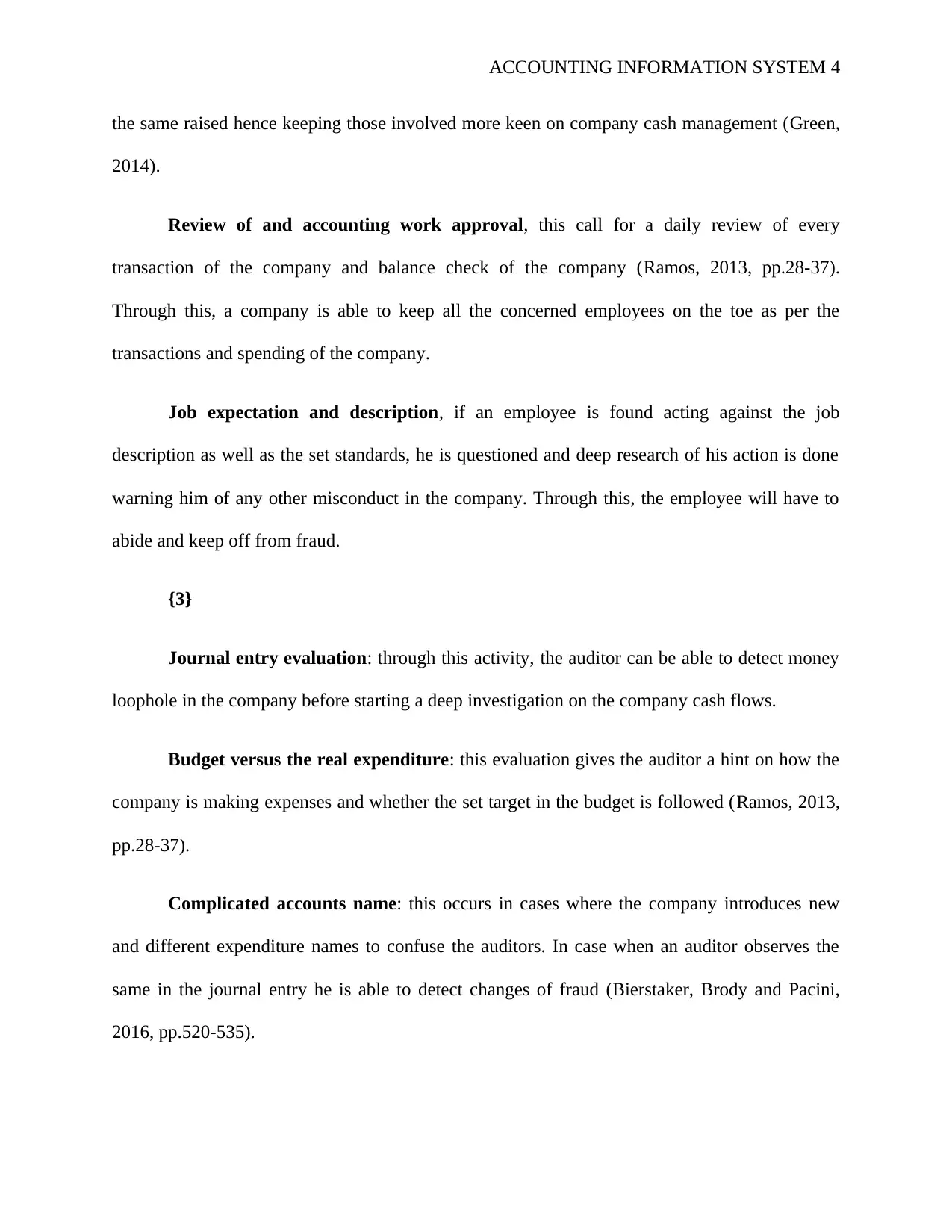
ACCOUNTING INFORMATION SYSTEM 4
the same raised hence keeping those involved more keen on company cash management (Green,
2014).
Review of and accounting work approval, this call for a daily review of every
transaction of the company and balance check of the company (Ramos, 2013, pp.28-37).
Through this, a company is able to keep all the concerned employees on the toe as per the
transactions and spending of the company.
Job expectation and description, if an employee is found acting against the job
description as well as the set standards, he is questioned and deep research of his action is done
warning him of any other misconduct in the company. Through this, the employee will have to
abide and keep off from fraud.
{3}
Journal entry evaluation: through this activity, the auditor can be able to detect money
loophole in the company before starting a deep investigation on the company cash flows.
Budget versus the real expenditure: this evaluation gives the auditor a hint on how the
company is making expenses and whether the set target in the budget is followed (Ramos, 2013,
pp.28-37).
Complicated accounts name: this occurs in cases where the company introduces new
and different expenditure names to confuse the auditors. In case when an auditor observes the
same in the journal entry he is able to detect changes of fraud (Bierstaker, Brody and Pacini,
2016, pp.520-535).
the same raised hence keeping those involved more keen on company cash management (Green,
2014).
Review of and accounting work approval, this call for a daily review of every
transaction of the company and balance check of the company (Ramos, 2013, pp.28-37).
Through this, a company is able to keep all the concerned employees on the toe as per the
transactions and spending of the company.
Job expectation and description, if an employee is found acting against the job
description as well as the set standards, he is questioned and deep research of his action is done
warning him of any other misconduct in the company. Through this, the employee will have to
abide and keep off from fraud.
{3}
Journal entry evaluation: through this activity, the auditor can be able to detect money
loophole in the company before starting a deep investigation on the company cash flows.
Budget versus the real expenditure: this evaluation gives the auditor a hint on how the
company is making expenses and whether the set target in the budget is followed (Ramos, 2013,
pp.28-37).
Complicated accounts name: this occurs in cases where the company introduces new
and different expenditure names to confuse the auditors. In case when an auditor observes the
same in the journal entry he is able to detect changes of fraud (Bierstaker, Brody and Pacini,
2016, pp.520-535).
Paraphrase This Document
Need a fresh take? Get an instant paraphrase of this document with our AI Paraphraser
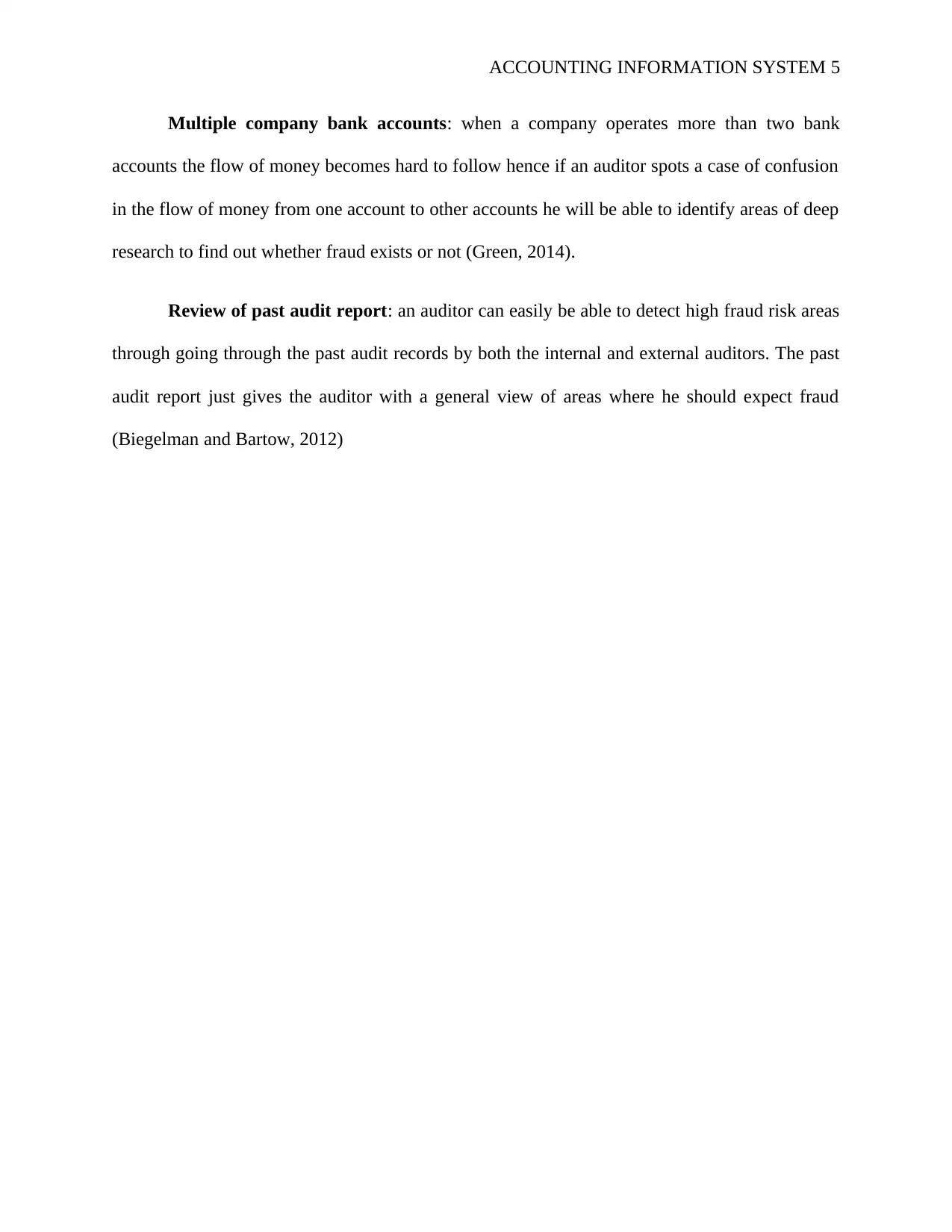
ACCOUNTING INFORMATION SYSTEM 5
Multiple company bank accounts: when a company operates more than two bank
accounts the flow of money becomes hard to follow hence if an auditor spots a case of confusion
in the flow of money from one account to other accounts he will be able to identify areas of deep
research to find out whether fraud exists or not (Green, 2014).
Review of past audit report: an auditor can easily be able to detect high fraud risk areas
through going through the past audit records by both the internal and external auditors. The past
audit report just gives the auditor with a general view of areas where he should expect fraud
(Biegelman and Bartow, 2012)
Multiple company bank accounts: when a company operates more than two bank
accounts the flow of money becomes hard to follow hence if an auditor spots a case of confusion
in the flow of money from one account to other accounts he will be able to identify areas of deep
research to find out whether fraud exists or not (Green, 2014).
Review of past audit report: an auditor can easily be able to detect high fraud risk areas
through going through the past audit records by both the internal and external auditors. The past
audit report just gives the auditor with a general view of areas where he should expect fraud
(Biegelman and Bartow, 2012)
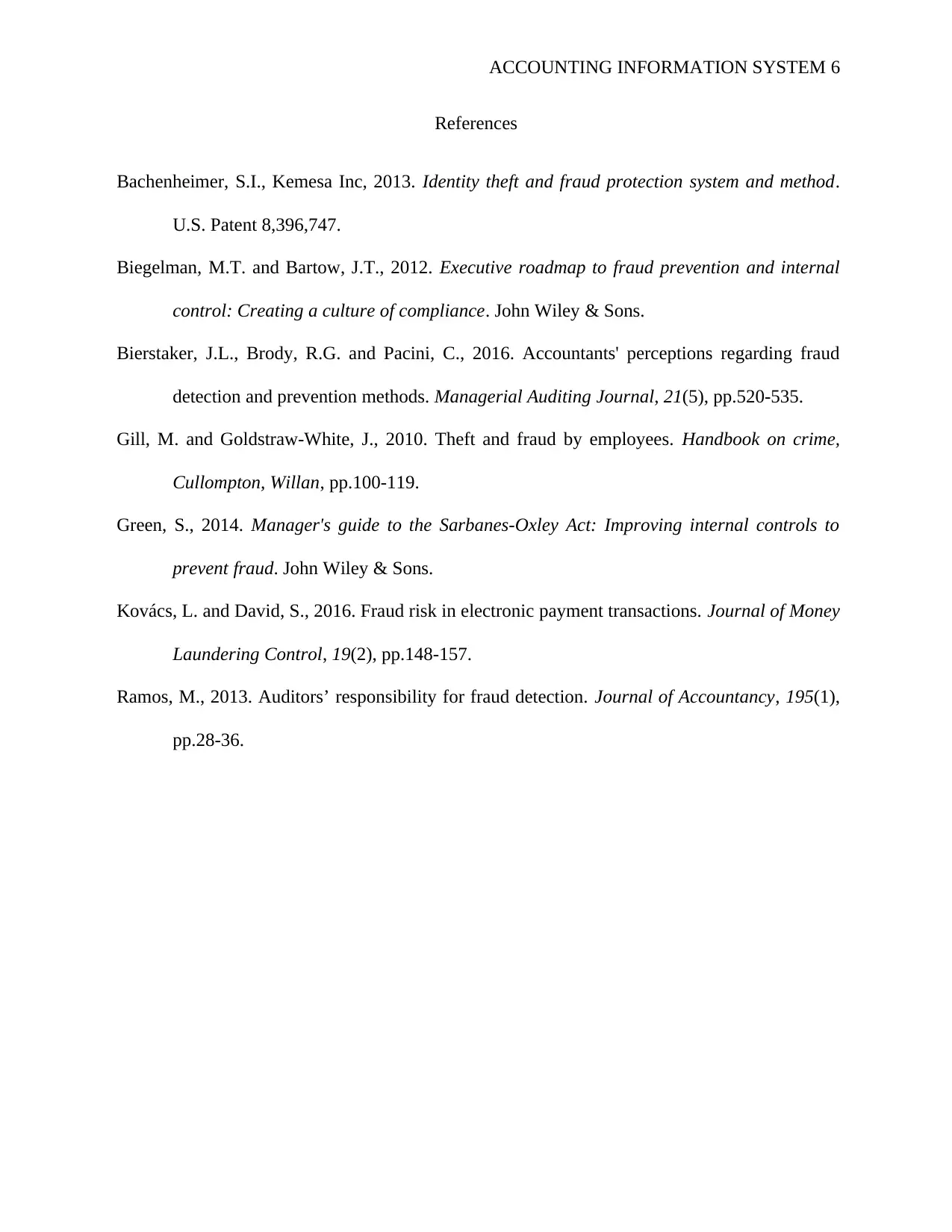
ACCOUNTING INFORMATION SYSTEM 6
References
Bachenheimer, S.I., Kemesa Inc, 2013. Identity theft and fraud protection system and method.
U.S. Patent 8,396,747.
Biegelman, M.T. and Bartow, J.T., 2012. Executive roadmap to fraud prevention and internal
control: Creating a culture of compliance. John Wiley & Sons.
Bierstaker, J.L., Brody, R.G. and Pacini, C., 2016. Accountants' perceptions regarding fraud
detection and prevention methods. Managerial Auditing Journal, 21(5), pp.520-535.
Gill, M. and Goldstraw-White, J., 2010. Theft and fraud by employees. Handbook on crime,
Cullompton, Willan, pp.100-119.
Green, S., 2014. Manager's guide to the Sarbanes-Oxley Act: Improving internal controls to
prevent fraud. John Wiley & Sons.
Kovács, L. and David, S., 2016. Fraud risk in electronic payment transactions. Journal of Money
Laundering Control, 19(2), pp.148-157.
Ramos, M., 2013. Auditors’ responsibility for fraud detection. Journal of Accountancy, 195(1),
pp.28-36.
References
Bachenheimer, S.I., Kemesa Inc, 2013. Identity theft and fraud protection system and method.
U.S. Patent 8,396,747.
Biegelman, M.T. and Bartow, J.T., 2012. Executive roadmap to fraud prevention and internal
control: Creating a culture of compliance. John Wiley & Sons.
Bierstaker, J.L., Brody, R.G. and Pacini, C., 2016. Accountants' perceptions regarding fraud
detection and prevention methods. Managerial Auditing Journal, 21(5), pp.520-535.
Gill, M. and Goldstraw-White, J., 2010. Theft and fraud by employees. Handbook on crime,
Cullompton, Willan, pp.100-119.
Green, S., 2014. Manager's guide to the Sarbanes-Oxley Act: Improving internal controls to
prevent fraud. John Wiley & Sons.
Kovács, L. and David, S., 2016. Fraud risk in electronic payment transactions. Journal of Money
Laundering Control, 19(2), pp.148-157.
Ramos, M., 2013. Auditors’ responsibility for fraud detection. Journal of Accountancy, 195(1),
pp.28-36.
⊘ This is a preview!⊘
Do you want full access?
Subscribe today to unlock all pages.

Trusted by 1+ million students worldwide
1 out of 6
Related Documents
Your All-in-One AI-Powered Toolkit for Academic Success.
+13062052269
info@desklib.com
Available 24*7 on WhatsApp / Email
![[object Object]](/_next/static/media/star-bottom.7253800d.svg)
Unlock your academic potential
Copyright © 2020–2025 A2Z Services. All Rights Reserved. Developed and managed by ZUCOL.





